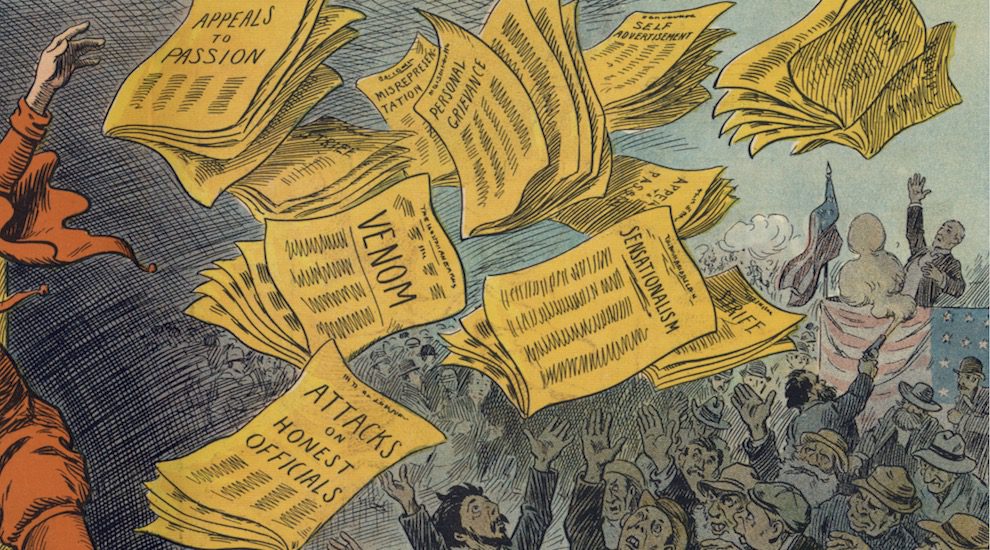
By Laura Hazard Owen, for NiemanLab
“Recognition of altruism as a motive for publishing (i.e. shedding a light on unknown/hidden information).”
The growing stream of reporting on and data about fake news, misinformation, partisan content, and news literacy is hard to keep up with. This weekly roundup offers the highlights of what you might have missed.
“Extreme users,” disinformation version. Mandy Jenkins, a 2019 John S. Knight Journalism Fellow at Stanford and the former editor-in-chief of Storyful, will soon be setting out to do in-person interviews with consumers of disinformation across the U.S., to investigate what newsrooms can learn from them. She wrote in a recent post:
Right now, I am identifying six to eight broad user types (in design thinking parlance, they are called ‘extreme users’) within the U.S. to help focus my study. Most people who share false news stories are not activists, trolls, politics junkies or meme creators, but those sort of users in the disinformation ecosystem are well placed to help us identify the needs of a wider population. These users will not be representative of any one group or demographic, but rather, they are case studies focused on the individual and their worldview.
Exactly how I’ll identify my ‘test subjects’ is still in the works, but will largely involve finding individuals who have followed particular sharing patterns on Facebook associated with one of the user types. From there, it’s on me to convince them to participate in the study. This winter, I will go into the field to meet my case study subjects face-to-face, ideally at their homes, to observe their environments and empathetically interview them to better uncover their tension points, media habits and more…
The plan right now is for me to have these interviews done by early spring so I can transcribe them, pull out insights, note surprises and identify problem areas for the users, with the hope there will be some commonality between user types. I will then compile those findings into a very basic report, along with case studies on the (not identified) users, to share with newsrooms, who are best placed to take this work into the next stages of ideation, prototyping and testing with their own audiences. Fingers crossed I can get everything done in time.
In a Newsgeist panel last month, Jenkins and An Xiao Mina led a session on “the strengths of journalism and disinformation and what we in media should seek to learn from those strengths.” Group members came up with this list of “strengths of effective disinformation,” and “the bolded strengths [below] were those we as a group felt are aspirational to be adapted into (or improved) in legitimate journalism practice.”
Strengths of Effective Disinformation
— Speed of publishing
— Novelty and excitement of new information
— Responsiveness to news events and reactions
— Cooperative amplification between competitors
— Simplification of difficult subject matter
— Trust through a lack of affiliation and complicity with institutions
— Liberated from legal and ethical norms
— Playing to emotions, fears, biases and reactions
— Recognition of altruism as a motive for publishing (i.e. shedding a light on unknown/hidden information)
— Audience participation (i.e. share this to help spread the word)
— Tapping into a community’s passions and beliefs
— Allowing the audience to feel as if they are part of an investigation or exposure of truths
— Engaging visuals
— Drives a desire to share
— Successful business model driven by attention economics
— Great at targeting on Facebook and other social networks
— Offering related content on the same topics
— Identity validation of the reader
What do conservatives believe about news? Tow Center fellows AJ Bauer and Anthony Nadler have an FAQ in CJR about the history of conservative news in the U.S. “We are co-editing a book on conservative news cultures that we’re hoping will help bring together different strands of research. We’re also working, along with Magda Konieczna of Temple University, with the Tow Center for Digital Journalism on research to illuminate the news values and routines animating conservative newsrooms through interviews with conservative news reporters and editors.” They write:
One of us (Nadler) has been conducting interviews with conservative news consumers in Southeastern Pennsylvania. A theme that has emerged is that many conservative news consumers feel strongly that their personal identity, as conservative, is under assault by liberals and liberal institutions. Many interviewees believe that liberals see conservatives as deeply morally flawed and seek to humiliate them and exclude them from any legitimate place in political discourse.
Conservative news amplifies these beliefs by focusing on stories that reinforce them. The intense feelings of threat can make any criticism of conservative politicians or policies — whether lodged by news commentators or celebrities — appear tied to efforts to humiliate conservatives. This is part of what makes the overarching story told by conservative news compelling to its audiences: Not only is so much at stake in terms of political outcome, but also the political contest is pitched as a battle with forces striving to degrade and shame the very conservative identity shared among the audience.
“I have many sources of existential dread in my life and at times this is one of them.” BuzzFeed’s Craig Silverman did a Reddit AMA. Excerpt:

By Laura Hazard Owen, for NiemanLab




